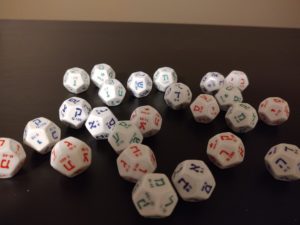
Dice are the main game components that determine acts of risk and chance in the Milhamah RPG.
Dice keep things unpredictable and interesting. In Bible days, the high priest, when seeking the will of God, would consult a mysterious tool called the urim and thummim, roughly translated as “lights and perfections.”
One tradition say the urim and thummim were similar to lots, where stones were taken out of the pouch of the priest’s apron. Another tradition says the urim and thummim involved the light of the menorah gleaming off the letters inscribed on the priest’s breastplate, which created messages that were supposed to contain messages from God.
While the Milhamah RPG dice merely determine gameplay outcomes and not any sort of divine will, they are still a special set of 12-sided dice, aka D12s.
There are 12 dice to the set:
- Two pairs of red dice (4)
- Two pairs of blue dice (4)
- Two pairs of green dice (4)
Each pair makes up the full 22-letter ‘Ivrit alefbet plus two Wild faces.

- Hebrew letter
- Corresponding Latin letter
- Gematria number
Besides an ‘Ivrit letter, each die face has a Latin letter A = א and a number to also make the game playable and understandable for non-Hebrew speakers. The number on the die may be used to calculate attack damage, or it may be added or subtracted with other dice to reach a gematria number target.
Dice descriptions
For rule purposes, dice may be described with a color and counted by adding a “D” after a numeral: 1D, 2D, 3D, etc. Faces will be noted as their Hebrew letters, though the associated numbers may accompany descriptions when relevant.
Temurah ciphers
So why have three different dice color types? The dice are color-coded to represent three ciphers: atbash, albam and akhbi. Each cipher is based on converting one Hebrew letter to another, based on a code or rubric.
Atbash: The first letter of the alphabet becomes the last letter and vice-versa; the second letter becomes the penultimate letter and vice versa; and so on.
ל-כ ,מ-י ,נ-ט ,ס-ח ,ע-ז ,פ-ו ,צ-ה ,ק-ד ,ר-ג ,ש-ב ,ת-א
In each pair listed on the red dice, the left and right letters will appear on opposite sides of a die. Wild faces will also each be on opposite sides. Here are the dice configurations for each Atbash die (W=Wild):
פ-ו ,צ-ה ,ק-ד ,ר-ג ,ש-ב ,ת-א
W-W, צ-ה ,ק-ד ,ר-ג ,ש-ב ,ת-א
ל-כ ,מ-י ,נ-ט ,ס-ח ,ע-ז ,פ-ו
ל-כ ,מ-י ,נ-ט ,ס-ח ,ע-ז, W-W
Albam: Split the alphabet down the middle into two sets. The first letter in one set becomes the first in the other, the second letter in one set becomes the second in the other, and so on:
ת-כ ,ש-י ,ר-ט ,ק-ח ,צ-ז ,פ-ו ,ע-ה ,ס-ד ,נ-ג ,מ-ב ,ל-א
On the blue dice, the left letter and the right letter in each row will be on opposite sides. Wild faces will also each be on opposite sides. Here are the dice configurations for each Albam die (W=Wild):
פ-ו ,ע-ה ,ס-ד ,נ-ג ,מ-ב ,ל-א
W-W, ע-ה ,ס-ד ,נ-ג ,מ-ב ,ל-א
ת-כ ,ש-י ,ר-ט ,ק-ח ,צ-ז ,פ-ו
ת-כ ,ש-י ,ר-ט ,ק-ח ,צ-ז, W-W
Akhbi: This is sort of a combination of Atbash and Albam. Divide the alphabet down the middle into two sets of letters. Each set turns its own first letter into the last, and so on.
פ-פ ,צ-ע ,ק-ס ,ר-נ ,ש-מ ,ת-ל ,ו-ו ,ז-ה ,ח-ד ,ט-ג ,י-ב כ-א
On the green dice, the left letter and the right letter in each row will be on opposite sides, expect in the case of ו and פ. In this case, each letter has a Wild on its opposite side instead of the same letter. Here are the dice configurations for each Akhbi die (W=Wild):
ו-W, ז-ה ,ח-ד ,ט-ג ,י-ב כ-א
פ-W, צ-ע ,ק-ס ,ר-נ ,ש-מ ,ת-ל
Making a cipher swap
Instead of a reroll, players may usually opt during their reroll phase to swap colors and convert at least three of the same-colored dice via a Temurah cipher.
Example: You roll an א with a blue die, but you really want a ת. Instead of re-rolling the blue die (which doesn’t have a ת on it anyway), you can swap it for a red die — א face up — and then flip it 180 degrees to get the Atbash, a ת.
Likewise, had you wanted a כ, you could’ve done the same thing by swapping the blue die for a green one under Akhbi. If you wanted a ל, you could simply flip the blue die over under Albam.
To do a Terumah cipher:
- Instead of rolling, swap out three or four of the dice in their dice pool that are the same color. Note that you cannot perform Temurah on a wild die.
- Replace all of them with a different color of your choice (but the same for all of the dice). Each converted die must have the same face value. For instance, to do Akhbi, a red gimel must be switched out for a green gimel.
- Finally, flip over each “color-transformed” die to its opposite side.
Here’s a neat trick: You can skip a die from Atbash to Albam to Akhbi and then back to Atbash, and the end result will show the same letter you started with!

You must be logged in to post a comment.